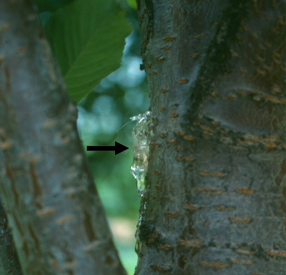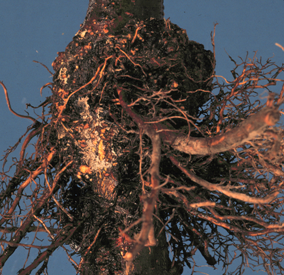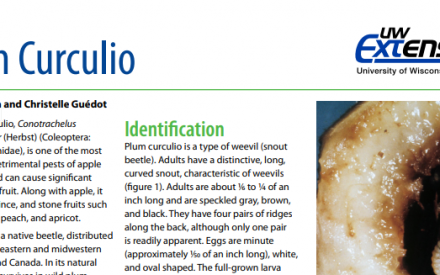What is plum pox?
Plum pox, also known as “sharka,” is one of the most devastating diseases of stone fruits (plums, peaches, nectarines, and apricots) worldwide. This viral disease was first discovered on plums in Bulgaria in 1915 and subsequently has been observed in many parts of the world. There are several variants of plum pox, but only one has been found in the United States. This variant was first found in peach orchards in Pennsylvania in 1999 (the first report of plum pox in North America). In 2006, the same variant was identified in Michigan and New York. Primary hosts of the U.S. plum pox variant are peach, plum, and ornamental Prunus species. Cherries and almonds are not considered natural hosts of this variant, but they can be artificially infected. Other plum pox hosts include garden plants (e.g., tomatoes, peas, petunias, zinnias) and weeds (e.g., white clover, lamb’s quarters). While plum pox does not kill stone fruit trees, it causes serious crop losses by making fruit deformed, discolored, tasteless, and unmarketable. In 2019, after intense quarantine and destruction of infected trees and orchards, the United States Department of Agriculture declared that plum pox had been eradicated from the United States.

What does plum pox look like?
Plum pox symptoms vary widely depending on host plant, plant age, plant nutrient status, environmental conditions, plum pox variant, and timing of infection. Some infected plants do not exhibit any visible symptoms or may not develop symptoms until years after infection, making plum pox difficult to detect. Additionally, symptoms may not be visible throughout an entire plant but limited to only a portion of the plant. Once a plant starts to show symptoms however, it will continue to do so in subsequent years. Of the stone fruits, plums are generally most severely affected by plum pox and show the most obvious symptoms. Branches on infected trees may develop spots. Leaves may develop yellow-green spots or blotches and mild, light-green discoloration near leaf veins (see photo above) that can be difficult to distinguish from other causes (e.g., nutrient deficiencies). On peach trees, leaf crinkling, puckering, and curling may also occur. Fruits may develop yellow rings or line patterns and become brown or necrotic (see photo above). As fruits ripen, symptoms fade, but fruits drop from the tree prematurely. Seeds may have white rings or line patterns.
Where does plum pox come from?
Plum Pox is caused by the Plum pox virus (PPV). PPV-D (one of six PPV variants/strains) is the only strain that has been detected in the United States. PPV can be moved long distances via infected nursery stock such as infected trees or budwood used for grafting. Once introduced into an orchard, the virus is spread short distances by aphids. Aphid transmission occurs more frequently in spring and autumn. PPV can overwinter in various parts of a tree, including the roots.
How do I save a tree with plum pox?
Once a tree has been infected with PPV, it cannot be cured. Timely and complete eradication of infected trees and even entire orchards is the only effective way to prevent further spread. Diseased trees (including stumps) should be removed and destroyed (i.e., burned and/or buried). Trees surrounding a problematic area should be monitored frequently for symptom development. Other potential host plants (see above) should also be monitored for symptoms of disease. If you see what you believe to be plum pox symptoms, contact your local plant disease diagnostic clinic immediately (see http://npdn.org/ for the lab nearest you). In Wisconsin, contact the UW-Madison Plant Disease Diagnostics Clinic (PDDC) at (608) 262-283 or pddc@wisc.edu. PPV is a federally regulated pathogen and if detected, infected plants must be destroyed to prevent further spread. Find more information on the federal regulation of PPV from the USDA.
How do I avoid problems with plum pox in the future?
After 20 years and elimination of over 1,500 acres of fruit trees, PPV has been eradicated in the United States. Preventing reintroduction of the PPV in the United States is critical. To prevent reintroduction of PPV, only use nursery stock that is certified virus-free. Also consider planting resistant varieties, but keep in mind that existing resistant varieties can still carry the virus and be asymptomatic. Additional control strategies for plum pox include managing aphids that can transmit PPV, following quarantine regulations, and routinely scouting and surveying orchards for plum pox and PPV. Ongoing monitoring for plum pox in stone-fruit-producing states and regulating imported trees will help ensure that the United States remains free of PPV.
For more information on plum pox:
Contact the University of Wisconsin Plant Disease Diagnostics Clinic (PDDC) at (608) 262-2863 or pddc@wisc.edu.
Authors: Emma Nelson and Leslie Holland, UW-Madison Department of Plant Pathology
Last Revised: 03/01/2024
D-number: D0082
References to pesticide products in this publication are for your convenience and are not an endorsement or criticism of one product over similar products. You are responsible for using pesticides according to the manufacturer’s current label directions. Follow directions exactly to protect the environment and people from pesticide exposure. Failure to do so violates the law.
Thanks to Patty Meister, Josie Russo and Carol Shirk for reviewing this document.
A complete inventory of UW Plant Disease Facts is available at the University of Wisconsin-Madison Plant Disease Diagnostics Clinic website: https://pddc.wisc.edu.
Send a Plant Sample for Analysis
Be cautious when self-diagnosing plant health issues. Very few diseases can accurately be diagnosed by eye.
Contact the UW Plant Disease Diagnostics Clinic (PDDC), and for a small fee, clinic staff can examine a plant, determine the cause of the disease/disorder, and provide advice on how to control or prevent the issue.
Download Article





 Bacterial Canker
Bacterial Canker Black Knot
Black Knot Crown Gall
Crown Gall Plum Curculio
Plum Curculio


